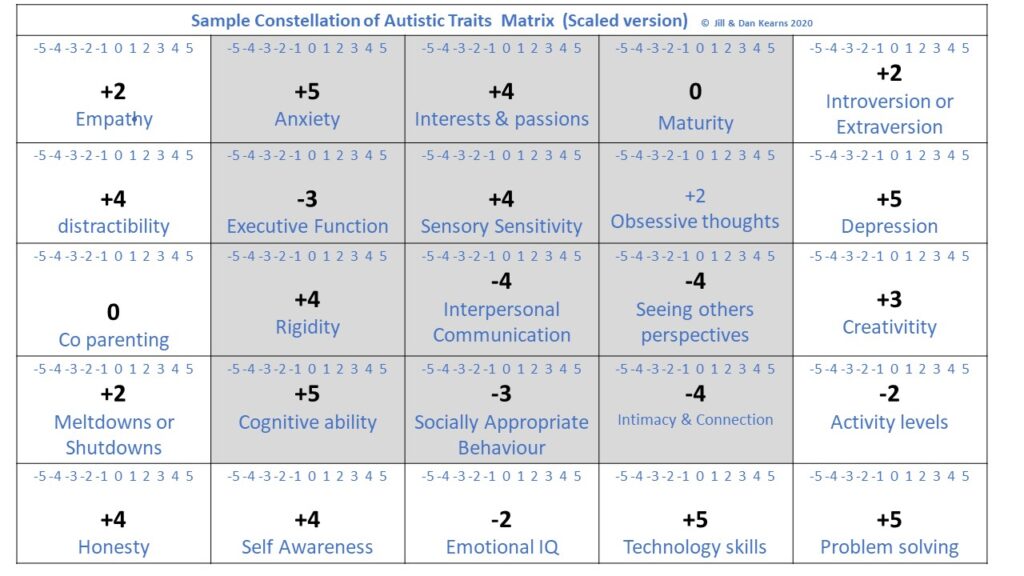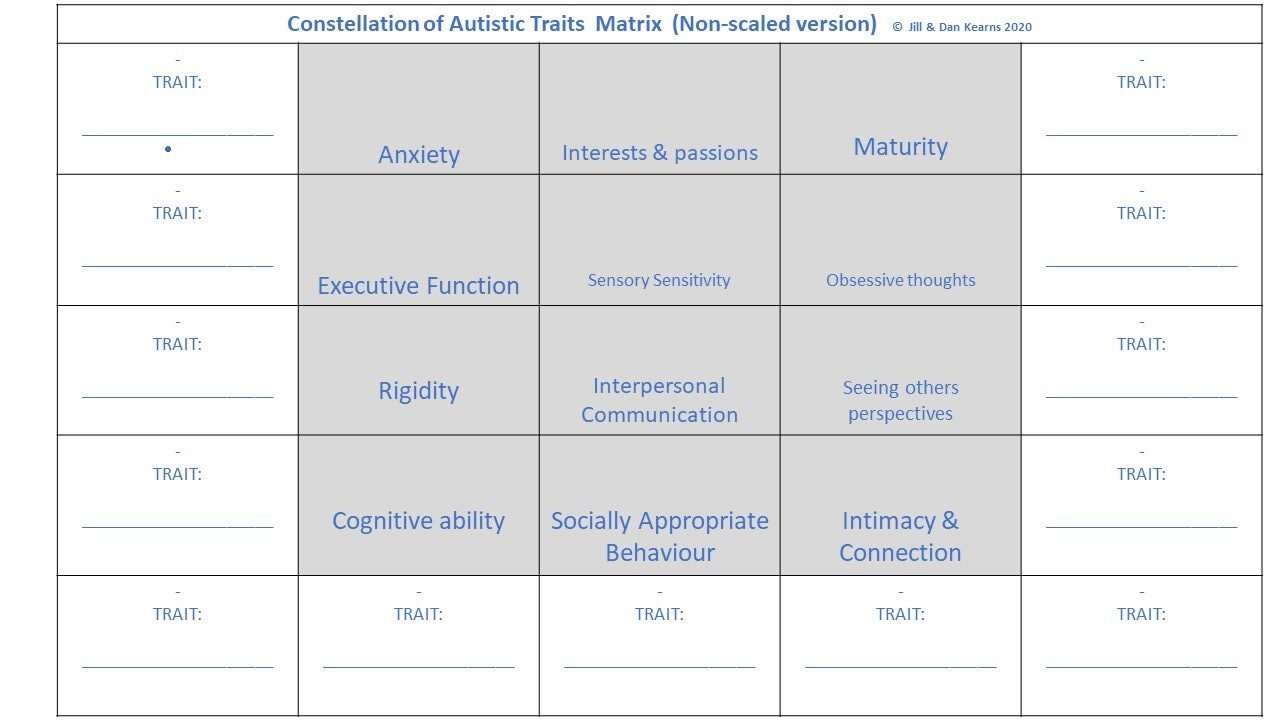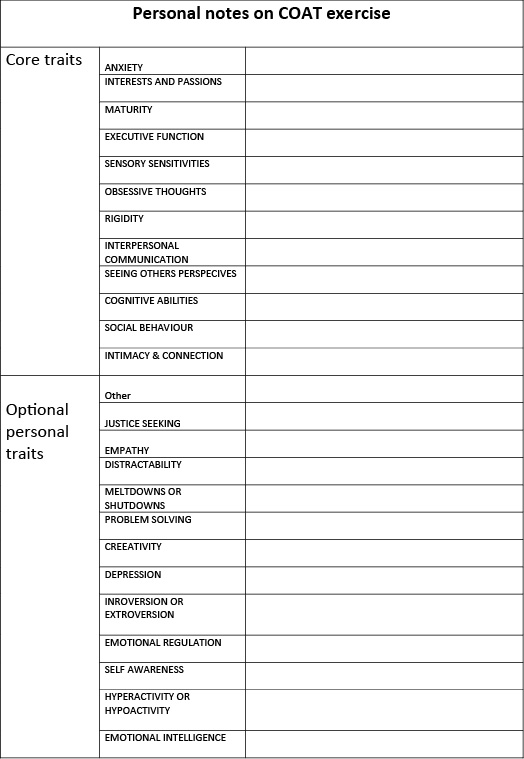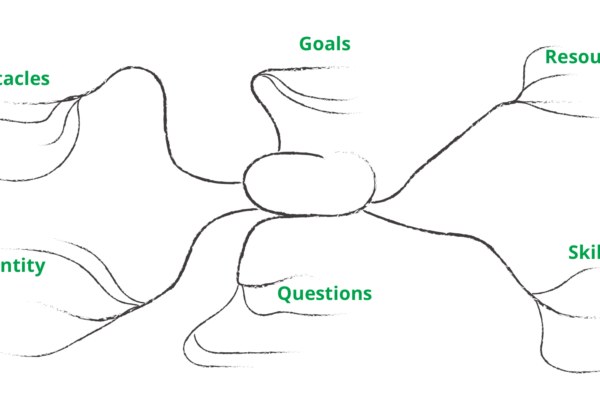Dan & Jill Kearns March 2020
Often, after a family member has been diagnosed with autism, the parents are becoming interested in their own diagnosis or recognise similar traits in a parent or relative. Further discussions may include the traits of their parents or other more distant relations. Moreover, earlier failed relationships, mental health difficulties, social difficulties or employment barriers may fuel the interest in cataloguing these traits.
Our clients have often self-diagnosed or ‘spouse diagnosed’ and may have then gone on to receive a formal diagnosis under the DSM-V. The multi-dimensionality and idiosyncratic characterisation of autism/Aspergers, however, is often minimised by the weight of the DSM-V criteria. Regardless of whether a formal diagnosis is achieved, clients remain confused about their new identity that becomes interpreted by the three D’s – disorder, disability, diagnosis.
This tool is to help a person describe their own unique ‘constellation of autistic traits’[1]. The matrices and table attached to the back of this paper provides the focus for this exercise and honours the truism that “If you’ve met one person with autism, you’ve met one person with autism.” – Dr. Stephen Shore. .A valuable aspect of this exercise is that a discussion about autism/Aspergers with a client is not confined to the descriptors of the DSM-V or to the confusion around autism/Aspergers and neurodiversity.
THE Constellation of Autistic Traits MATRIX

The COAT matrix has twenty-five cells in which twelve characteristic traits associated with the autism/Aspergers profile are provided in the shaded core cells and thirteen cells surrounding these provide an opportunity for the client to add other traits they associate with their autistic/Aspergers strengths and challenges.
There are two templates provided at the back of this paper. The first option gives a rating of -5 -to + 5 for each trait and the second option is not scaled. The non-scaled matrix lets the client write their own comments in the cell and in the descriptive table attached to the back of the matrix. A client can use both the scaled version and the descriptive table.
In the scaled version, there is an option to rate oneself from a strength to a deficit in the trait but this can be ambiguous and requires explanation. For example in the Sample Matrix, the client has graded themselves -4 in Interpersonal Communication, indicating they are challenged in this trait, while they rate themselves 0 for Maturity indicating they are normal in maturity for their age, and +3 for Creativity to indicate they are somewhat artistic. +5 for Justice Seeking could be valued or be a challenge.
The process for completing this exercise with the client is to:
- Introduce the concept that in the general population, people vary in their personal traits across many dimensions. That this multidimensionality exists also within the profile of autism/Aspergers.
- State that this exercise is valuable as a process and not a diagnosis. The insights and conversations are more important than the scores.
- The client rates themselves using the shaded cells of the Scaled Matrix (-5 to +5) and may use the Traits Table to add further description.
- The client can consider inserting up to 13 personal traits in the outer cells and rate these also.
- Optionally, the client can use the Non-Scaled Matrix and also use the Traits Table to describe their rating in more detail.
- The client can be encouraged to share the exercise with a therapist, spouse or other to encourage insights for both parties.
- Work with the client to select a few traits to work on to improve relationships, mental health or employment goals.
- Repeat the exercise periodically.

The benefits of the exercise is to:
- Introduce the concept that in the general population, people vary in their personal traits across many dimensions. That this multidimensionality exists also within the profile of autism/Aspergers.
- develop a sense of self awareness, empowerment and a positive sense of identity.
- to encourage insights for the client’s spouse, employer, family and therapists.
- to improve relationship, mental health or employment goals.
- To avoid pathologizing the autistic/Aspergers condition or profile
 Feel free to provide us with feedback on this tool or request templates in Word format at danokearns@gmail.com
Feel free to provide us with feedback on this tool or request templates in Word format at danokearns@gmail.com
[1] Mendes, E 2015, Marriage and lasting relationships with Asperger’s Syndrome (autism spectrum disorder): Successful strategies for couples or counselors, Jessica Kingsley, London. P.15.
Mendes, E 2015, Marriage and lasting relationships with Asperger’s Syndrome (autism spectrum disorder): Successful strategies for couples or counselors, Jessica Kingsley, London. P.15.

